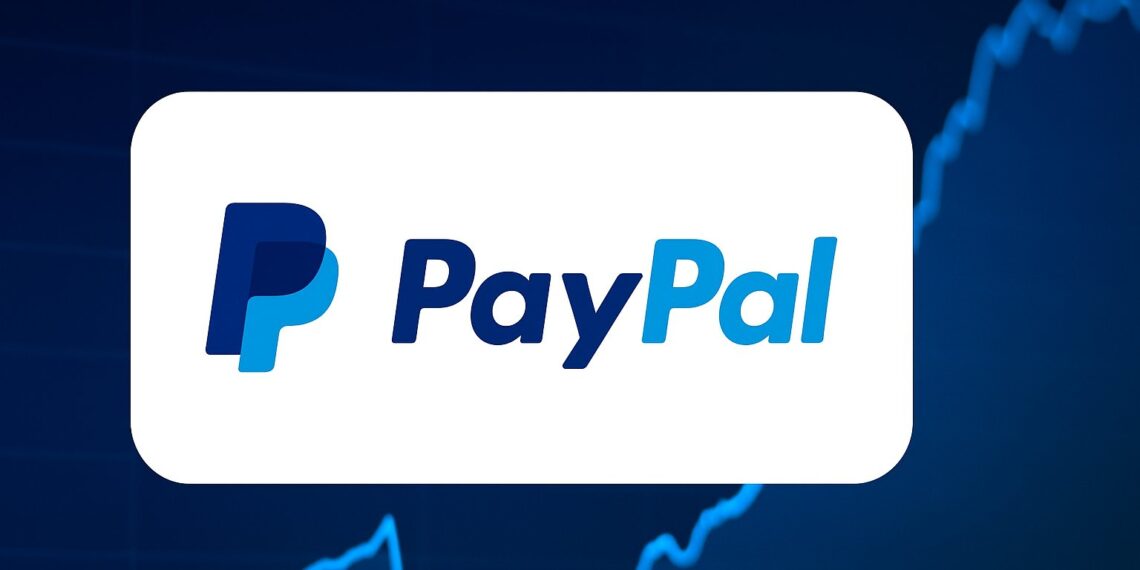The PayPal stock (NASDAQ: PYPL) is showing fresh momentum. After months of stagnation and investor uncertainty, the U.S. fintech giant is back in focus — driven by a new partnership with Google and the launch of an innovative advertising platform for small businesses.
Shares climbed around 3% in recent trading, now hovering near $73.00, as investors cheered PayPal’s push into new revenue streams and its renewed focus on growth. With these moves, PayPal aims to evolve from a pure payments company into a full-service digital commerce ecosystem — and the market is taking notice.
The question for investors: Is this rally just the start of a sustainable comeback?
From Payment Processor to Platform Powerhouse
For years, PayPal was synonymous with online payments. The company built its reputation as one of the first and most trusted digital payment systems — a must-have tool for eBay sellers and online merchants.
But as the fintech space matured, competition grew fiercer. Players like Stripe, Block (Square), Adyen, Apple Pay, and traditional banks began offering faster, cheaper, or more flexible solutions. PayPal’s once-dominant position started to erode, and its growth slowed.
Now, the company is repositioning itself for a new era. Instead of focusing solely on transactions, PayPal is becoming a comprehensive platform for digital commerce — combining payments, data, advertising, and artificial intelligence.
The newly unveiled advertising platform for small and medium-sized enterprises (SMEs) marks a major step in that direction. It allows merchants to create and target ads directly through PayPal, leveraging insights from transaction data to reach potential customers.
For small businesses, it’s an opportunity to advertise more effectively. For PayPal, it’s a bold move into a high-margin sector that could transform its revenue mix.
A Strategic Partnership With Google
The second — and arguably bigger — catalyst behind the recent rally in PayPal stock is the company’s strategic partnership with Google.
This multi-year collaboration aims to deepen PayPal’s integration across Google’s vast ecosystem. The two companies will work together to improve digital payment solutions, advertising technology, and cloud infrastructure.
Key elements of the partnership include:
- Integrating PayPal as a primary payment option across Google services such as Google Ads, the Play Store, and Google Cloud.
- Leveraging Google Cloud infrastructure to enhance PayPal’s data processing, analytics, and scalability.
- Co-developing AI-driven shopping experiences, sometimes called “agentic commerce” — where artificial intelligence can autonomously recommend, compare, and even complete purchases on behalf of users.
This alliance could reshape how online transactions happen — fusing payments, data, and automation.
For PayPal, it’s a technological leap that expands its reach far beyond its traditional user base. For Google, it’s a way to strengthen its payments backbone and tap into PayPal’s massive network of merchants and consumers.
Investor Confidence Returns
After years of mixed performance, investors are rediscovering their optimism in PayPal stock.
Under CEO Alex Chriss, who took over in late 2023, PayPal has embarked on a disciplined turnaround. The company is focusing on three main areas: operational efficiency, product innovation, and ecosystem expansion.
Key improvements are already visible:
- Cost restructuring has boosted operating margins and freed up cash for innovation.
- New product rollouts — such as PayPal Complete Payments and Venmo for Business — are attracting fresh merchant sign-ups.
- PayPal’s venture into digital assets and stablecoins, including its own PayPal USD (PYUSD), is positioning it at the intersection of fintech and blockchain.
For long-term investors, these shifts suggest that PayPal’s best days may not be behind it — they may just be entering a new phase.
Stock Performance and Valuation
The past two years have been rough for PayPal shareholders. The stock lost nearly 75% of its value from its 2021 peak above $300. But now, after months of consolidation, signs of recovery are emerging.
At around $73.00 per share, PayPal’s market capitalization stands near $75 billion — a fraction of its former valuation but still robust.
With a price-to-earnings ratio in the low 20s, PayPal trades at a discount to many fintech peers, offering a compelling setup for value-oriented investors.
Analysts see significant upside potential if the company can sustain double-digit growth again. Average 12-month price targets range between $85 and $90, with some optimistic projections pointing toward a return to three-digit levels over the next two years.
The New Advertising Platform: PayPal’s Hidden Gem
PayPal’s new advertising platform for small businesses could quietly become one of its most profitable ventures.
By enabling merchants to promote products within the PayPal ecosystem, the company is monetizing one of its most valuable assets — data. With access to transaction histories, purchase patterns, and demographics of millions of users, PayPal can offer highly targeted advertising with measurable conversion rates.
For merchants, this means lower customer acquisition costs. For PayPal, it means recurring, high-margin revenue — a crucial step in reducing dependence on transaction fees.
If executed effectively, this strategy could transform PayPal into a fintech hybrid: part payment processor, part data-driven advertising company — similar to how Amazon monetized its marketplace with advertising.
Data and Artificial Intelligence: PayPal’s New Frontier
PayPal processes billions of transactions annually, giving it deep insight into global consumer behavior.
With its new strategy, the company plans to turn that data into actionable intelligence. By applying AI to transaction flows, PayPal aims to enhance fraud prevention, personalize financial products, and optimize marketing for merchants.
This data-driven approach could also support the development of new products, including microloans, credit solutions, and personalized investment options.
In the long term, it could push PayPal toward a more diversified, AI-powered business model — transforming it from a payments platform into a broader financial technology ecosystem.
The Google Partnership: A Win-Win for Both Giants
The partnership with Google brings massive strategic benefits.
For Google, PayPal provides a trusted global payment framework, essential for user retention and monetization across its platforms. For PayPal, Google offers access to advanced AI, cloud infrastructure, and one of the largest digital advertising ecosystems in the world.
This combination could unlock new user experiences — seamless cross-platform shopping, one-click payments, and integrated financial tools embedded into daily digital life.
In a world where digital ecosystems are consolidating, this collaboration could prove as transformative as the partnership between Apple and Goldman Sachs in launching the Apple Card.
Competitive Landscape: Standing Strong in a Crowded Market
The digital payments industry is fiercely competitive. Companies like Stripe, Adyen, Block (Square), and Apple Pay are all vying for dominance.
But PayPal’s advantage lies in its scale and trust. With over 400 million active accounts worldwide, a strong regulatory track record, and decades of brand recognition, PayPal has what newer entrants lack: credibility and infrastructure.
Moreover, while competitors focus on narrow verticals — like point-of-sale terminals or developer tools — PayPal is building a comprehensive ecosystem that spans payments, advertising, AI, and even crypto.
This holistic approach may be PayPal’s best chance to regain long-term leadership in digital finance.
Financial Health and Profitability
PayPal’s financial position remains solid. The company generates annual revenue of about $30 billion, with operating margins around 17%.
Although profitability has dipped slightly due to heavy investment in R&D and new product development, management expects margins to recover as these initiatives scale.
Free cash flow remains strong — roughly $5 billion per year — giving the company ample flexibility to pursue acquisitions, buybacks, and shareholder returns.
PayPal has already reduced costs by streamlining operations and focusing resources on core growth segments. The financial foundation for sustainable expansion appears stable.
Opportunities and Risks for Investors
Opportunities
- New revenue streams from advertising and data monetization
- Synergies with Google boosting global reach and technical capabilities
- AI-driven commerce solutions enhancing user experience
- Continued growth in mobile and e-commerce payments
- Attractive valuation compared to fintech peers
Risks
- Execution risk with new platforms and technologies
- Dependence on Google partnership for ecosystem integration
- Intensifying competition from Stripe, Block, and traditional banks
- Regulatory pressures in data privacy and digital currencies
- Macroeconomic headwinds that could impact consumer spending
Analyst Outlook and Investment Strategy
Analysts are cautiously optimistic about PayPal’s revival. The consensus: the stock is undervalued, but success depends on flawless execution of its new strategy.
For investors, a phased entry strategy may be prudent — buying gradually during dips in the $65–68 range while holding for long-term growth potential.
The key indicators to watch in upcoming quarters include:
- Advertising revenue growth from the SME platform
- Progress on the Google integration
- Trends in active user numbers and payment volume
- Margin recovery and cost discipline
If these metrics improve, PayPal could regain its position as a leading fintech innovator.
The Broader Picture: PayPal’s Reinvention
The current rally in PayPal stock is more than a short-term rebound — it reflects a deeper transformation.
PayPal is reshaping its identity from a payment processor into a data-driven, AI-enhanced digital commerce platform. The combination of new revenue models, advanced analytics, and strategic partnerships puts it in a stronger position than it has been in years.
For long-term investors, this could mark the start of a multi-year growth cycle — one rooted in fundamentals, not hype.
Conclusion: PayPal Stock Enters a New Phase of Growth
The PayPal stock comeback story is gaining credibility. The Google partnership, the new advertising initiative, and a sharper focus on innovation have reignited confidence in the company’s future.
After years of underperformance, PayPal is proving it can adapt, evolve, and compete at the highest level. Its combination of brand trust, global scale, and new technologies gives it a realistic path back to growth.
For long-term investors, PayPal remains a compelling fintech opportunity — a company in transition, but with the strategy and assets to thrive in the next era of digital finance.
FAQ – PayPal Stock
Why is the PayPal stock rising?
Because of positive investor sentiment following the launch of a small-business advertising platform and a strategic partnership with Google.
What’s the current PayPal stock price?
Shares trade around $69.50, showing signs of stabilization and upward momentum.
What’s the significance of the Google partnership?
It deepens PayPal’s integration with Google services, expanding its reach and enabling AI-driven commerce innovations.
Is PayPal stock undervalued?
Yes — relative to peers, PayPal trades at a modest valuation with room for a 20–30% upside if growth accelerates.
Is now a good time to buy PayPal stock?
For long-term investors, gradual accumulation during dips may offer an attractive entry point.
Disclaimer
This article is for informational and educational purposes only and does not constitute financial advice or investment recommendations.
All opinions reflect the author’s view at the time of publication. Investing in equities carries significant risks, including the potential loss of capital.







